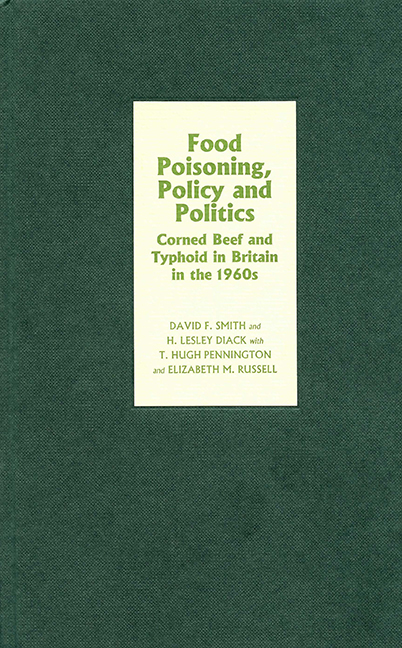Book contents
- Frontmatter
- Contents
- List of illustrations
- Preface and acknowledgements
- Abbreviations used in text
- Abbreviations used in footnotes
- 1 The earlier history of typhoid and food poisoning
- 2 The 1963 corned beef-associated typhoid outbreaks in Harlow, South Shields and Bedford
- 3 The Aberdeen typhoid outbreak
- 4 The medical officer of health, the media and the public in the Aberdeen typhoid outbreak
- 5 Ministers, officials and the Aberdeen typhoid outbreak
- 6 The Milne Committee of Enquiry
- 7 The recommendation on the inspection of overseas meat plants: the roles of existing policy agendas, and interdepartmental and inter-professional tensions
- 8 The disposal of suspect canned meat: the priority of politics over technical advice
- 9 British action to encourage improvements in Argentine meat hygiene, 1964 to 1969
- 10 Summary and conclusions, and food safety since 1964
- Appendix: Recommendations of the Milne Committee
- Bibliography
- Index
3 - The Aberdeen typhoid outbreak
Published online by Cambridge University Press: 24 October 2017
- Frontmatter
- Contents
- List of illustrations
- Preface and acknowledgements
- Abbreviations used in text
- Abbreviations used in footnotes
- 1 The earlier history of typhoid and food poisoning
- 2 The 1963 corned beef-associated typhoid outbreaks in Harlow, South Shields and Bedford
- 3 The Aberdeen typhoid outbreak
- 4 The medical officer of health, the media and the public in the Aberdeen typhoid outbreak
- 5 Ministers, officials and the Aberdeen typhoid outbreak
- 6 The Milne Committee of Enquiry
- 7 The recommendation on the inspection of overseas meat plants: the roles of existing policy agendas, and interdepartmental and inter-professional tensions
- 8 The disposal of suspect canned meat: the priority of politics over technical advice
- 9 British action to encourage improvements in Argentine meat hygiene, 1964 to 1969
- 10 Summary and conclusions, and food safety since 1964
- Appendix: Recommendations of the Milne Committee
- Bibliography
- Index
Summary
Introduction
During the Aberdeen typhoid outbreak, the Director of Aberdeen university's student health service, Harold Worth, recorded in a letter to the BMJ details of the illnesses of two female students, the first typhoid cases. According to Worth, on Tuesday, 12 May 1964, one student visited her doctor complaining of a carbuncle on her back and was taken into residential medical accommodation at Crombie hall of residence. The following day the carbuncle was clearing, but the student developed a fever and her temperature was 103°F by the Thursday. Her flatmate sickened and, on Friday 15 May, with a temperature of 104°F, she was admitted to Crombie sick-bay. During the evening, the second student suffered diarrhoea, while the following day the first had a nosebleed. On the Saturday evening, both were transferred to the nurses’ ward at Aberdeen Royal Infirmary, Foresterhill, and were there barrier-nursed. An interview with Worth's colleague, Dr Campbell Murray, expanded upon the circumstances: Worth and Murray were going to a conference, and did not want to leave their patients in Crombie in their absence. Their access to hospital beds arose from their responsibility for nurses as well as students.
Bacteriological investigations were carried out at Foresterhill at the laboratory of Alexander MacDonald, professor of bacteriology at Aberdeen University. Michael McEntegart, MacDonald's deputy, recalled that on 19 May he was on duty with trainee consultant J. A. Smith. Smith asked McEntegart to look at a slide of a micro-organism he had cultured and McEntegart, having experience of typhoid while in the Royal Army Medical Corps, recognised the organism as Salmonella typhi. McEntegart recalled that when James Brodie, Director of the Regional Hospital Board laboratory at the City Hospital was informed, ‘there was a sort of gasp at the other end of the phone’. That morning, Brodie had obtained five cultures of gram negative organisms from blood samples, but assumed that they were contaminants. He phoned back later to say his assumption had been wrong.
- Type
- Chapter
- Information
- Food Poisoning, Policy and PoliticsCorned Beef and Typhoid in Britain in the 1960s, pp. 58 - 95Publisher: Boydell & BrewerPrint publication year: 2005



